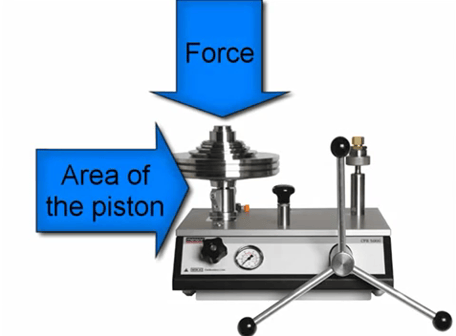A deadweight tester generates pressure by exerting a force (F) over an area (A), which is also the definition of pressure (P): P = F/A
In a deadweight tester, the force is supplied by a mass in a gravitational field on top of a piston with a specific cross-sectional area that rotates within a cylinder. This piston cylinder system is manufactured to very tight tolerances for smooth, precision operation. The fluid (pneumatic or hydraulic) under the piston is pressurized so the piston and mass “float” in equilibrium. The pressure in the fluid is equal to the force exerted by the mass over the cross sectional area of the piston.
This is a very simple and straightforward conceptual explanation, however in practice, the force and the cross sectional area of the piston are affected by environmental conditions.
The force is affected by gravity, which tends to be slightly different depending on your location and elevation on the surface of the earth. These differences are significant when determining the pressure generated by a deadweight tester. Local gravity can be estimated using the National Geographic Society / NOAA Calculator, or a more precise value can be obtained from an on-site gravity survey from an accredited organization.
As an example, the gravity value taken from the NOAA calculator for the Mensor factory location is 979232 +/- 5 milligals. The accredited gravity survey conducted at Mensor gave a result of 979230.9 milligals, only about a 1 milligal difference. This may or may not be typical. In addition, the downward force created by the mass is also affected by the upward buoyancy force created by the surrounding atmosphere.
The area of the piston is affected by the temperature of the piston, which may change the effective area of the piston due to expansion or contraction. The area is also affected by the pressure surrounding the piston.
An equation that takes all of these influences into account is used to calculate the actual pressure generated by the deadweight tester.
The video below offers a visual explanation of how a deadweight tester works to generate pressure for calibration.
Manufacturers of deadweight testers will usually have an automated way to make corrections for these environmental factors and to determine the mass to generate a given pressure. The WIKA CPU6000 (formerly the CPU5000) can calculate the mass required to generate any pressure, sense the environmental conditions and factor them into the equation to calculate the pressure.
Related Reading:


